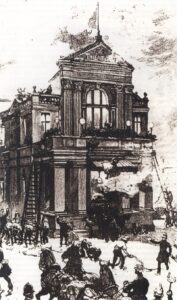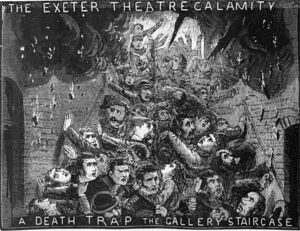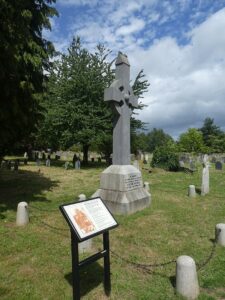 In American schools, and maybe in schools all over the world, children are used to the occasional fire drill, because it is a practice is designed to allow people to escape a fire, instead of losing their lives in a panic. Of course, this practice is fairly new, and came about after a number of fire disasters. One such disaster was the September 5, 1887, Exeter Theatre Royal fire in Exeter, England.
In American schools, and maybe in schools all over the world, children are used to the occasional fire drill, because it is a practice is designed to allow people to escape a fire, instead of losing their lives in a panic. Of course, this practice is fairly new, and came about after a number of fire disasters. One such disaster was the September 5, 1887, Exeter Theatre Royal fire in Exeter, England.
The fire broke out in the backstage area of the theatre during the production of “The Romany Rye” by George Robert Sims and produced by Wilson Barrett. When the fire was known, a panic ensued throughout the theatre. Whenever there is panic, someone is going to get hurt, or worse. In this case, 186 people died from a combination of the direct effects of smoke and flame, crushing and trampling, and trauma injuries from falling or jumping from the roof and balconies. It is such a sad situation, because if they had not panicked, it is likely that all or most of those would have survived. Of course, panic was not the only reason for the deaths, so we will never truly know if this could have been prevented. The Exeter Theatre Royal death toll makes it the worst theatre disaster, the worst single-building fire, and the third worst fire-related disaster in the history of the United Kingdom. Most of those who lost their lives were in the gallery of the theatre, which had only a single exit with several design flaws. The exit quickly became clogged with people trying to escape.
This was not the first time the Theatre Royal had been destroyed. The first Exeter Theatre Royal had been gutted by fire in 1885, and the new theatre was opened, on a new site, in 1886 to the design of well-known theatre architect CJ Phipps. The new theatre was leased exclusively to Sidney Herberte-Basing. The new  building was constructed from stone and red brick on the outside, but the inside was largely constructed of wood. Following the 1885 fire, the licensing authority of Exeter City Council ordered that the new theatre be constructed “in accordance with the rules and regulations of the Metropolitan Board of Works,” which was a statutory requirement in London under The Metropolitan Building Act 1855 (with theatre particulars added in the 1878 amendment), but not required in the regions. In his letter accompanying the plans to the Corporation Surveyor of Exeter City Council, Phipps directly states that the building met all the rules and requirements laid out, ans added that he had extensive experience in these types of construction. The letter stated, “…the theatre is designed in accordance with the rules and regulations of the Board of Works under the Act of 1878 and of the Lord Chamberlain – and having constructed some 40 theatres, I bring a somewhat large experience to bear on this subject.” – C.J. Phipps, Letter of 11 July 1885 from Phipps to the Corporation Surveyor of the City of Exeter.
building was constructed from stone and red brick on the outside, but the inside was largely constructed of wood. Following the 1885 fire, the licensing authority of Exeter City Council ordered that the new theatre be constructed “in accordance with the rules and regulations of the Metropolitan Board of Works,” which was a statutory requirement in London under The Metropolitan Building Act 1855 (with theatre particulars added in the 1878 amendment), but not required in the regions. In his letter accompanying the plans to the Corporation Surveyor of Exeter City Council, Phipps directly states that the building met all the rules and requirements laid out, ans added that he had extensive experience in these types of construction. The letter stated, “…the theatre is designed in accordance with the rules and regulations of the Board of Works under the Act of 1878 and of the Lord Chamberlain – and having constructed some 40 theatres, I bring a somewhat large experience to bear on this subject.” – C.J. Phipps, Letter of 11 July 1885 from Phipps to the Corporation Surveyor of the City of Exeter.
Nevertheless, during the licensing inspection, several deficiencies were noted and ordered to be corrected, including “installing an additional exit for the audience from the boxes, stalls, and pit, widening the exits to at  least 6 feet, changing some single leaf exit doors to double doors, and supplying 80 feet of hose for each hydrant (of which there were only two – one in the foyer and one in the “prompts” in front of the stage), rather than 40 feet which had been provided.” Unfortunately, there was no inspection of the stage, the mezzanine floor, or the fly galleries above the stage. There was only one exit with four right angled turns in it, from this area, and while two exits were called for, the idea was passed over because Phipps asserted “that a second exit was provided by climbing the railing at the front of the gallery and dropping to the second circle below.” That was, of course a crazy notion, that cost lives in the end. Apparently, this plan was accepted without further argument. In addition, there was to be an iron safety curtain, which was not fitted at the time of the fire, and a fire hydrant in the stage wings was on the plans of the theatre but never installed, despite Phipps being advised that the two hydrants installed were insufficient. In the end, the panic, along with the mishandled inspections and the improper plan design cost 186 people their lives.
least 6 feet, changing some single leaf exit doors to double doors, and supplying 80 feet of hose for each hydrant (of which there were only two – one in the foyer and one in the “prompts” in front of the stage), rather than 40 feet which had been provided.” Unfortunately, there was no inspection of the stage, the mezzanine floor, or the fly galleries above the stage. There was only one exit with four right angled turns in it, from this area, and while two exits were called for, the idea was passed over because Phipps asserted “that a second exit was provided by climbing the railing at the front of the gallery and dropping to the second circle below.” That was, of course a crazy notion, that cost lives in the end. Apparently, this plan was accepted without further argument. In addition, there was to be an iron safety curtain, which was not fitted at the time of the fire, and a fire hydrant in the stage wings was on the plans of the theatre but never installed, despite Phipps being advised that the two hydrants installed were insufficient. In the end, the panic, along with the mishandled inspections and the improper plan design cost 186 people their lives.


One Response to Exeter Theater Royal Fire